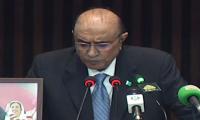The opening of the Kartarpur Corridor is one of the most outstanding achievements of a government in recent times. When was the last time Pakistan valued its heritage this way and employed its soft power in this manner? When was the last time the heavily guarded and fenced borders of the two nuclear armed rivals opened up to welcome millions of people seeking peace and spiritual blessing. Nanak, it appears, is doing his magic five and a half centuries after he was born on this land.
India has stubbornly refused to recognise, let alone reciprocate, this step, which can be seen as an unprecedented confidence building measure (CBM). India is ruled by a party that thrives on hatred, persecution of minorities and jingoism. The fact that Pakistan has taken this step almost unilaterally, in the absence of any dialogue or prospects of a thaw in bilateral relations, makes it even more profound and valuable.
By providing millions of Sikhs visa-free access to one of their holiest sites, Pakistan has done a favour to itself as well. Sikhs are a community linked to this land through an umbilical cord of spirituality. Though mostly citizens of a different country, they are the sons and daughters of the valley of the Indus. Their exodus from this land was never a part of the scheme of Partition.
Sikhs’ places of pilgrimage are important to the community as some of the most sacred places on earth, but they are equally valuable to us as our precious heritage. They are linked to the sages and seers who belonged to this land. They are linked to our history and evolution of civilization, social thought and wisdom on this land. It is a heritage that Pakistan can be rightfully proud of. The 550th anniversary of the birth of Guru Nanak is not only a religious event for Sikhs but a national event for Pakistan as well. In his poem on Nanak, Iqbal called him a ‘mard-e-kamil’ (a perfect man) who raised India from slumber.
In his statesman-like speech at the event, the prime minister of Pakistan emphasised the importance of the national heritage and its role in building bridges, promoting peace and developing economy. His policy is a continuation of a direction that Pakistan appears to have taken in the last decade. During this period, we have seen a process of introspection taking shape at the highest level of the state. Pakistan has finally chosen a path that is very different from the one recently taken by many countries in the world, including India. We have been there and we know how much self-harm it may result in.
We have seen the legislature, executive and judiciary taking a number of steps to correct some of the wrongs done to minorities in Pakistan. New laws have been passed, the executive has taken a number of steps and the judiciary has taken many proactive measures to protect the rights of minorities.
Many historic temples and places of worship that were closed since Partition have been handed back to worshippers once again and governments have set aside resources for their revival and protection. The PPP has been at the forefront of these efforts but other parties have not been far behind.
Siddiqul Farooq, a leader of the PML-N did a wonderful job as the chairperson of the Evacuee Trust Property Board (ETPB), taking excellent care of Hindu temples, particularly the Katas Raj temple complex. A five percent jobs quota has been reserved for the religious minorities at the federal and provincial levels.
These are only first steps that mark a change in direction. A lot needs to be done to protect, promote and celebrate Pakistan’s rich and plural human and cultural resources and heritage. Dozens of valuable archeological sites, including Taxila, await exploration. Many excavated sites, including Moenjodaro, fear the risk of irreversible damage. Many identified archeological sites are being encroached upon, plundered and destroyed.
Our museums resemble 19th-century railway stations and many artefacts inside them are decaying and disappearing. Most artefacts in the Lahore museum, for example, are exposed to humidity and temperature in a building that no one can imagine using as a museum in the 21st century. A layer of dust can be seen on many exhibits, while many other exhibits, including precious manuscripts are attracting fungi. Artefacts that should be guarded through laser lights are behind simple glass cabinet secured through thirty-year-old locks.
Many years ago, when I complained about this situation to the curator of the museum, he explained that he hardly had the resources to provide basic facilities to visitors and keep toilets clean. If our government values our heritage, it must allocate more resources to protect them.
We have seen some improvement in this situation after the province took control of archeological sites post the 18th Amendment. A number of historic sites have been restored with foreign support. Personal attention by His Highness Aga Khan has played an important part in protecting and restoring some sites.
The excellent restoration of the Shahi Hammam (the royal bath) is one such example. It is hard to imagine today that it was a public bath in fact, built to provide sustainable funding to the nearby Wazir Khan Masjid. Both buildings formed part of the city centre of the second most important city of an empire that was the richest state in the world at that time.
I would like the government to take one more step for sake of those who left this land 70 years ago. This step may also be a unilateral one because reciprocity is hard to imagine from the Modi government.
The ruling elite of the post-colonial South Asian states failed to understand the pain of those who migrated to or from their land though many of them were themselves migrants. The only thing that was worth debating and legislating was the property they had left. In Pakistan, they were termed evacuees. In India, those who left for Pakistan, or were forced to migrate, are termed as enemies by law (the Enemy Property Act 1968) and their properties cannot be inherited even by their children who opted to stay.
Those who had migrated on the eve of Independence are more than 70 years old now. They are a dying generation, but most of them still carry the hope to make a parting visit to their ancestral places. Both India and Pakistan have maintained a harsh visa regime for each other’s citizens.
Let’s put the members of this dying generation in a special category, granting them all a onetime visa to visit the places of their birth and, in addition, a city of their choice. No one has ever returned from Pakistan without being impressed by our hospitality. There is no reason that the children of this land, who are senior citizens now, will get a less than befitting welcome.
The writer is an anthropologist and development professional.
Email: zaighamkhan@yahoo.com
Twitter: @zaighamkhan
India uses Afghanistan as a backstage area to carry out terrorist attacks against Pakistan
Another report by the Pakistan Institute of Peace Studies states that 78 per cent of attacks have been carried out by...
Pakistan stands at the forefront of this crisis, generating a staggering 3.3 million tonnes of plastic waste annually
Today, a total of 11,000 children are attending Daanish schools in Punjab
The emotional instability of parents inculcates a range of psychological issues in children
The current way of dealing with the environment and climate change is no longer adequate







